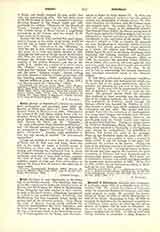

Berno (ABBOT OF REICHENAU), famous as orator, poet, philosopher, and musician, born (date unknown) at Prum near Trier; d. June 7, 1048. He became Abbot of Reichenau in 1008. Educated in the school of St. Gall, Berno visited Rome with the Emperor Henry II, and upon his return introduced many reforms in the liturgical music of his native land. Among his books are the “Tonarium”, “De varira psalmorum atque cantuum modulatione”, and “De consona tonorum diversitate”, all of which are contained in Migne’s “Patrology” and in Gerbert’s “Scriptores”. Another work attributed to him, but less known, is entitled “De instrumentis musicalibus”.
Living and writing at a time when the traditions of Rome and St. Gall were still fresh, Berno has left, in his works on music, a fruitful source of information to those who are interested in ascertaining and restoring the rhythmical form in which the Gregorian melodies were originally sung. Berno’s testimony, with that of other early writers, supports the view of those who hold that the Gregorian melodies consist of long and short note-values, as against the theory that all notes in the chant are of equal length.
J.F. SOLLIER

